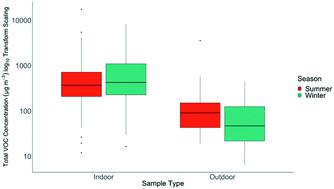当前位置:
X-MOL 学术
›
Environ. Sci.: Processes Impacts
›
论文详情
Our official English website, www.x-mol.net, welcomes your feedback! (Note: you will need to create a separate account there.)
Frequency of use of household products containing VOCs and indoor atmospheric concentrations in homes
Environmental Science: Processes & Impacts ( IF 5.5 ) Pub Date : 2021-4-12 , DOI: 10.1039/d0em00504e Aiden C. Heeley-Hill 1, 2, 3, 4 , Stuart K. Grange 1, 2, 3, 4 , Martyn W. Ward 1, 2, 3, 4 , Alastair C. Lewis 2, 3, 4, 5 , Neil Owen 4, 6, 7 , Caroline Jordan 4, 6, 7 , Gemma Hodgson 4, 8, 9 , Greg Adamson 10, 11, 12
Environmental Science: Processes & Impacts ( IF 5.5 ) Pub Date : 2021-4-12 , DOI: 10.1039/d0em00504e Aiden C. Heeley-Hill 1, 2, 3, 4 , Stuart K. Grange 1, 2, 3, 4 , Martyn W. Ward 1, 2, 3, 4 , Alastair C. Lewis 2, 3, 4, 5 , Neil Owen 4, 6, 7 , Caroline Jordan 4, 6, 7 , Gemma Hodgson 4, 8, 9 , Greg Adamson 10, 11, 12
Affiliation

|
Volatile organic compounds (VOCs) are a key class of atmospheric emission released from highly complex petrochemical, transport and solvent sources both outdoors and indoors. This study established the concentrations and speciation of VOCs in 60 homes (204 individuals, 360 × 72 h samples, 40 species) in summer and winter, along with outdoor controls. Self-reported daily statistics were collected in each home on the use of cleaning, household and personal care products, all of which are known to release VOCs. Frequency of product use varied widely: deodorants: 2.9 uses home per day; sealant-mastics 0.02 uses home per day. The total concentration of VOCs indoors (range C2–C10) was highly variable between homes e.g. range 16.6–8150 μg m−3 in winter. Indoor concentrations of VOCs exceeded outdoor for 84% of households studied in summer and 100% of homes in winter. The most abundant VOCs found indoors in this study were n-butane (wintertime range: 1.5–4630 μg m−3), likely released as aerosol propellant, ethanol, acetone and propane. The cumulative use VOC-containing products over multiday timescales by occupants provided little predictive power to infer 72 hour averaged indoor concentrations. However, there was weak covariance between the cumulative usage of certain products and individual VOCs. From a domestic emissions perspective, reducing the use of hydrocarbon-based aerosol propellants indoors would likely have the largest impact.
中文翻译:

家庭中含有挥发性有机化合物和室内大气浓度的家用产品的使用频率
挥发性有机化合物(VOC)是从室外和室内的高度复杂的石化,运输和溶剂来源释放的主要大气排放类别。这项研究确定了夏季和冬季以及室外对照的60个家庭(204个人,360×72 h样本,40种)中VOC的浓度和种类。在每个家庭中收集有关清洁,家用和个人护理产品使用情况的自我报告的每日统计数据,众所周知,所有这些产品都会释放挥发性有机化合物。产品使用的频率差异很大:除臭剂:每天在家中使用2.9次;除臭剂:密封胶0.02每天使用一次。室内VOC的总浓度(范围C 2 –C 10)在家庭之间变化很大,例如范围为16.6–8150μgm -3在冬季。在夏季研究的84%的家庭和冬天在100%的家庭中,室内的VOC浓度超过了室外。在这项研究中,室内发现的最丰富的VOC是正丁烷(冬季范围:1.5–4630μgm -3),可能以气溶胶推进剂,乙醇,丙酮和丙烷的形式释放。乘员在多天时间范围内累计使用的含有VOC的产品几乎无法提供推断72小时平均室内浓度的预测能力。但是,某些产品的累积使用量与单个VOC之间的协方差很小。从家庭排放的角度来看,减少室内使用碳氢化合物气溶胶推进剂的影响可能最大。
更新日期:2021-04-15
中文翻译:

家庭中含有挥发性有机化合物和室内大气浓度的家用产品的使用频率
挥发性有机化合物(VOC)是从室外和室内的高度复杂的石化,运输和溶剂来源释放的主要大气排放类别。这项研究确定了夏季和冬季以及室外对照的60个家庭(204个人,360×72 h样本,40种)中VOC的浓度和种类。在每个家庭中收集有关清洁,家用和个人护理产品使用情况的自我报告的每日统计数据,众所周知,所有这些产品都会释放挥发性有机化合物。产品使用的频率差异很大:除臭剂:每天在家中使用2.9次;除臭剂:密封胶0.02每天使用一次。室内VOC的总浓度(范围C 2 –C 10)在家庭之间变化很大,例如范围为16.6–8150μgm -3在冬季。在夏季研究的84%的家庭和冬天在100%的家庭中,室内的VOC浓度超过了室外。在这项研究中,室内发现的最丰富的VOC是正丁烷(冬季范围:1.5–4630μgm -3),可能以气溶胶推进剂,乙醇,丙酮和丙烷的形式释放。乘员在多天时间范围内累计使用的含有VOC的产品几乎无法提供推断72小时平均室内浓度的预测能力。但是,某些产品的累积使用量与单个VOC之间的协方差很小。从家庭排放的角度来看,减少室内使用碳氢化合物气溶胶推进剂的影响可能最大。


























 京公网安备 11010802027423号
京公网安备 11010802027423号